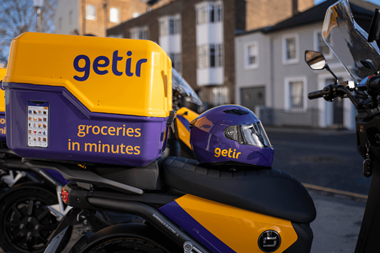Returns can be a costly burden, yet retailers’ supply chains are often ill-equipped to deal with them. Charlotte Hardie asks where savings can be made as unwanted gifts fly back to stores.
For cash-strapped consumers, unwanted Christmas presents are a veritable goldmine. In previous years, that garish festive jumper might have been stuffed at the bottom of a drawer or donated to a charity shop. This year, frugality is a priority and more shoppers than ever are likely to return unwanted gifts in exchange for much-needed cash.
To prove the scale of the problem, a study last year by the Cranfield School of Management estimated that about£7.88bn worth of goods were returned during 2007. Home Delivery Network chief executive Brian Gaunt says the carrier handles on average between 5 and 6 million returns from e-tailers and catalogues a year.
Retailers have spent the past few weeks desperately trying to shift as much stock as possible before Christmas and its unwelcome reappearance is costly. Time is money. The quicker retailers can get re-saleable product back on the shelves, and the most value they can get out of product that can’t be re-sold, the more benefit it will bring to the bottom line. The trouble is, far too little attention is paid to this area of the supply chain.
KSA Consulting senior manager Matthew Cushen says: “It’s seen as a small part of logistics and it’s not well measured. If you don’t measure it you don’t focus on how to improve it.” Gaunt agrees. “It’s not an area retailers spend much time trying to find solutions to,” he explains. Many stores in particular, he continues, are not geared up to take stock back. “It’s a logistical problem that takes up valuable floor space.”
And yet the cost of processing a return is generally at least one and a half, and up to as much as three times, the cost of the outbound shipment of the same item. Mark Hewitt, chief executive of iForce, which manages returns and reverse logistics for retailers such as Tesco and House of Fraser, says: “That’s why returns can devour 30 to 35 per cent of profits. With pressure on margins, the easiest way to add a few basis points is to sort out your refunds, but a lot of retailers don’t. Some don’t do anything. In the good times this hasn’t been the focus and it’s a huge opportunity wasted.”
Smooth operation
Littlewoods is one retailer that does devote time and attention to its returns system. Director of warehousing and returns Mike Heald says: “It can cause great upset to customers when it’s wrong and it impacts on profitability in so many ways because it’s such a large part of the business.”
To make life as easy as possible for customers, Littlewoods offers several ways in which they can return unwanted items, including allowing shoppers to give returns to the delivery driver when a subsequent order is delivered. Its operation is now so efficient that Heald says Littlewoods can process returns within a four-hour period from the point at which it receives them at its returns processing centre.
A crucial part of the returns system, and one that many retailers can focus on straightaway at very little cost, is what happens in stores. Ensuring staff are aware of the importance of the returns process can lead to more or less instantaneous improvements.
Take, for example, the codes that are keyed in by staff at the tills, which correspond to the reason given for the return. These are often largely ignored: it’s no coincidence that the code keyed in is usually “A” – the first on the drop-down menu; it’s quick and easy for staff who fail to see the importance of accuracy because it’s never been explained to them.
John Lewis places much emphasis on staff training. The partnership has a famously flexible returns policy – often without the need for a receipt. Head of supply chain and administration Andy Banks says: “All staff are trained in how to make decisions regarding returns themselves. In general we rely on the judgment of our partners and train them so that they feel comfortable making these decisions.”
Moreover, if staff are knowledgeable about the product they can help avoid unnecessary returns in the first place. Comet services director Toby Lousada says both staff who work on its dedicated customer service desks and its in-store service teams are crucial to minimising disruption caused by returns. As well as processing exchanges and refunds efficiently “they are able to give advice, screen products and assist customers with set-up problems”, he explains.
Last year Comet launched its 30-day helpline for customers who purchase digital products. Lousada says this has also been instrumental in reducing returns. “We can sort out set-up problems and compatibility issues with other converging products such as PCs, digital TV recorders and so on, often resolving frustrating teething problems for our customers without it being necessary for them to return to store,” he says.
Analysing collated returns data is another way to improve the process. Accenture has conducted significant research on what constitutes high performance supply chains. Global head of the fulfilment practice Jonathan Wright says one common characteristic is mature reverse logistics and returns capabilities. “It’s built into their end-to-end supply chains,” he explains.
Furthermore, more than three quarters of those that Accenture describes as supply chain “masters” take returns data and use it for product development. “They need to be capturing returns data, understanding why products are being returned and using it to drive continuous improvement. Retailers should look at returns as an opportunity; a real chance for customer intimacy,” he says.
In order to sort and deal with returned stock as quickly as possible, it is also vital to have an organised returns centre. This may sound obvious, but as Wright says: “It’s incredible how unstructured this area of the supply chain is. Often returns warehouses are chaos. Someone has to go through all that and work out what goes where.”
Until around two and a half years ago, returns for John Lewis were handled regionally and there was very little data on them stored. But it then set up a dedicated national returns centre to simplify the operation. Banks says: “The facility sorts products, routing perfect items back into stock at our direct-to-customer picking operation. Where the item has been opened and the packaging is not perfect, items are sent out to shops for sale with a small markdown.”
As a result of the improved efficiency created by the returns centre, a product can now be in consignment on its way back to the supplier in a matter of days instead of weeks. It’s as quick to get stock out of the system through reverse logistics as it is to get new stock from suppliers into its stores. The process also allows the retailer to highlight those products that are being returned and those being exchanged.
Consider the costs
Dealing with returns is a complicated business and retailers also need to consider how they deal with individual products. They often make the mistake of grouping specific types of returns into one vast entity and dealing with them in the same way. For instance, sending all faulty product back to the supplier might not be suitable for every category because of the cost incurred.
Retailers need to look more closely at the total cost of returns for different types of product. Processing the return of electrical goods is particularly expensive. Gaunt explains: “These products have to be processed, go back to the warehouse to be repackaged, checked and sent back to the store. That costs a lot of money.”
Wright says that a few years ago one of the large electrical retailers decided it wasn’t economically viable to send DVD players back to the manufacturer for repair and return them to customers. Instead, it replaced the customers’ product with a new one, took the defective machines elsewhere to get them repaired and sold them on in a different market, thus making significant cost savings. It’s only when retailers can understand how much it costs to deal with certain products that they can try to minimise expenditure.
Cushen adds that in certain product categories that have a high percentage of returns, there is scope for potential cost reductions during the buying process. “Some retailers are negotiating upfront with suppliers to take into account a high percentage of returns in certain categories, so that is already factored into the margin.”
And Hewitt points out that when buying from suppliers, retailers must check the contract so they know how to deal with returns in the event of a manufacturing fault. “Some suppliers won’t have clauses on that,” he says. “Retailers have to know the process. It needs focus and they have to have a system in place to deal with it.”
In 2007, Littlewoods invested in IT to improve returns processing. Heald says: “This has had several benefits, including speeding up the crediting of customer accounts and the routing of product. This helps us to maximise the profitability of returned items and speeds up the whole returns process.”
But making investments is not the only way to bring about improvement. Cushen says analysing existing ways of working will often highlight pointless activity. It’s not expensive or complicated to simply stop doing something.
Ultimately, retailers need to understand the true scale of the problems inherent in their returns strategies and work out what they need to do to improve them. As Cushen says: “If you look at it closely there will often be some surprises.”
Shoppers will be fussier than ever this year. The slightest hesitation or regret about a purchase is likely to send them running back to stores. And if they do, retailers need to ensure they have a good experience in order to foster customer loyalty. If retailers want to make a marked difference to their bottom line, vowing to revamp reverse logistics is one new year’s resolution definitely worth keeping.
























No comments yet